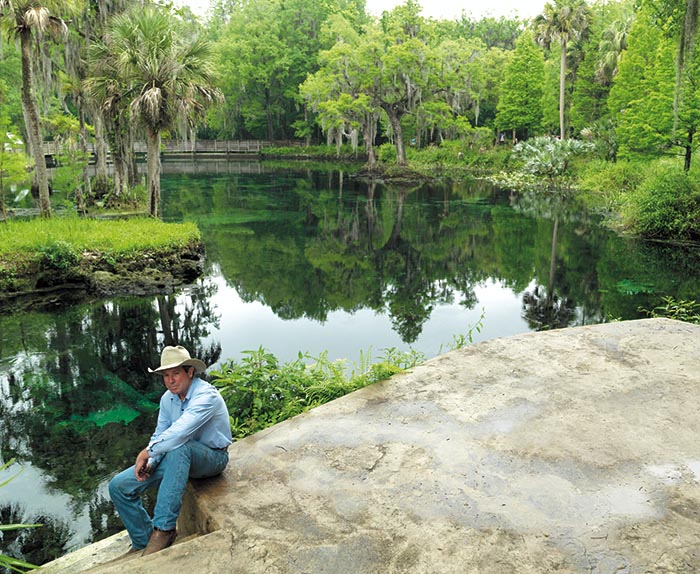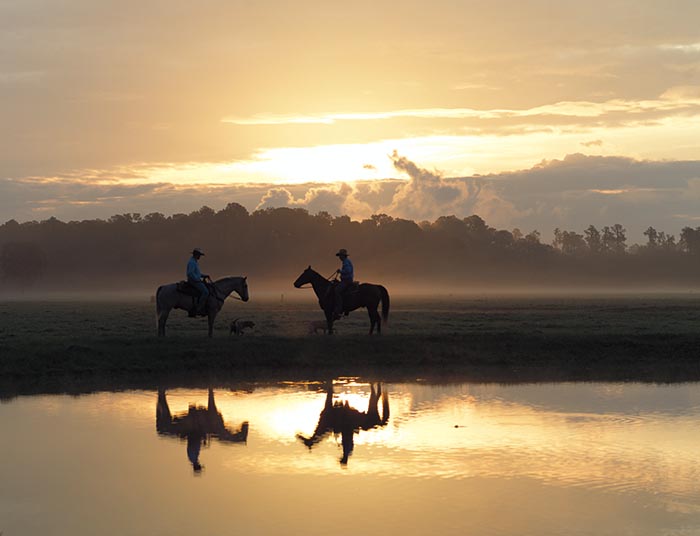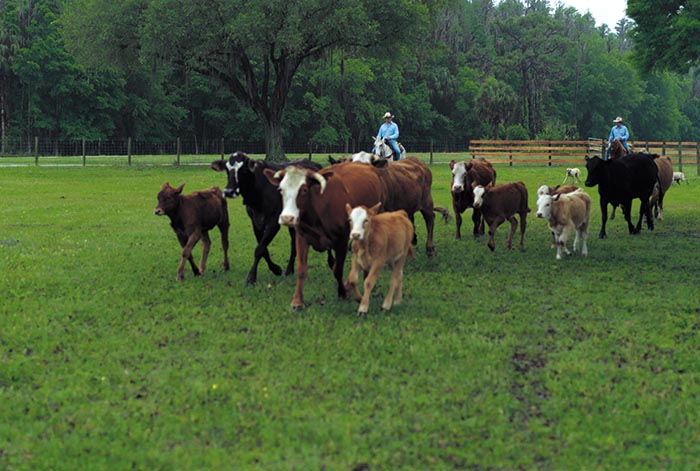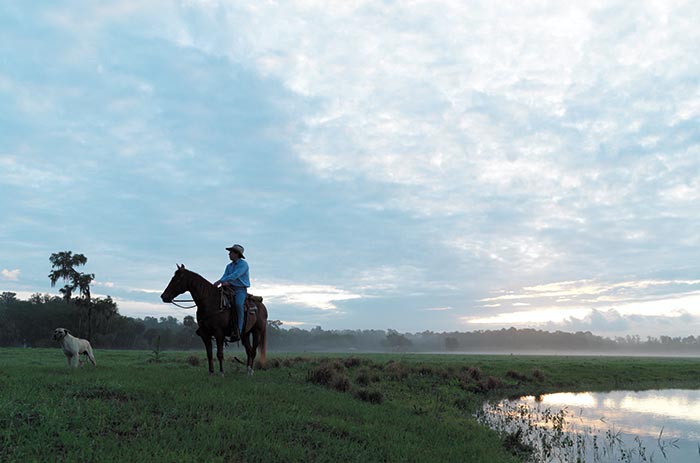
Part 3 In a Series of 4 on Florida’s Cattle Ranching Heritage
Robert Thomas he is wearing khakis and a long-sleeved button down dress shirt, sipping hot black tea in his office off U.S. 301. It’s 7 a.m. and the April sun has yet to pierce the fog draped over the flatwoods of his Two Rivers Ranch.
The west-central Florida cattle rancher has been awake for several hours and already took his early morning jog around the ranch, which at 14,000 acres is the largest piece of private, undeveloped land in Hillsborough County. He’s now dressed for an afternoon appointment in the city.
Thomas has a deep, powerful voice that makes him an intimidating man. On the surface, he looks like your average Tampa businessman. As the county’s second-largest landowner (next to the Mosaic phosphate company) and head of the biggest calf/cow operation in the region, his deep pockets and various connections have positioned him on some of the area’s biggest boards.
But don’t let the professional attire fool you. Underneath those dress shoes is a thin layer of mud and scrub grass.
Thomas is steward of his family’s vast property, which stretches across parts of Hillsborough, Pasco and Hernando counties. Over the years, he has shrouded himself in controversy over his decisions to develop large pieces of that land and lease its spring to the Zephyrhills Bottling Company. For that, he has built a reputation as both a smart investor and, in his words, a “greedy millionaire rancher.”
“I’ve gotten used to that,” Thomas says. “I figure, as long as we’re comfortable with what we’re doing, you can’t expect everyone to agree with you all the time. You can only be true to yourself and true to your convictions. And we’ve done that.”
Like it or not, Thomas represents a new breed of cattle rancher in Florida.

A Legacy Begins
To say Two Rivers Ranch has come a long way since it was purchased in 1932 is an understatement. Robert’s grandfather, Wayne Thomas, took a chance when he bought the near-barren landscape named after Hillsborough River and Blackwater Creek, which converge on the property. Here, ancient pine flatwoods that once blanketed the few thousand acres were clear-cut at the turn of the 20th century, leaving a once beautiful countryside of little value to him.
Wayne Thomas spent much of his life restoring that land by planting pine trees for timber production as a way to generate revenue and cover expenses. It took years for his conservative efforts to restore the property and draw wildlife back.
Cattle didn’t come until later. A Plant City newspaper publisher who also owned Port Sutton in Tampa, a phosphate shipping terminal he purchased on the cheap, Wayne Thomas was more savvy businessman than rancher. He made large profits selling phosphate-laden land and more money when the Tampa Port Authority decided it should have majority ownership of Tampa’s port and bought Port Sutton. Shortly after, Thomas hired a foreman to manage his property, marking the beginning of his family’s legacy in cattle ranching.
Over time, Wayne Thomas accumulated a massive trust of land and bequeathed it to his grandson, Robert, 14 at the time, and three granddaughters. Wayne Thomas died at 96 and left the ranching and phosphate duties to Robert’s father, Bob. Before he passed away, the family patriarch donated a portion of his land to the state, which is now the Hillsborough River State Park.
A Change of Hands
When Bob Thomas took over for his father, he did so with the intent to carry on his philanthropy and largesse. The founder of Hillsborough’s Joshua House, a shelter for abused and abandoned children, he gave generously to Jesuit High School, St. Joseph’s Hospital and Metropolitan Ministries— and helped bring an equestrian center to the Florida State Fairgrounds.
Having been stricken with polio at age 30, his ailment limited him physically, though Robert Thomas says that rarely stopped his father from loading the truck and taking he and his friends to the ranch.
“I remember every Saturday morning waking dad up with a group of friends in the driveway ready to head up to the ranch,” he says. “We’d grab cane poles, oil cans with worms to go fishing, .22 rifles, maybe a few horses. We just had a good time.”
In the city, Bob Thomas’ legacy was connected to his charitable work. But in the ranching world, he was best known for his new “contour pine planting” technique that allowed trees to utilize nutrients in the surface water around wetlands. The innovation helped him earn the Tree Farmer of the Year Award in 1976.
By the time Robert Thomas was 14, he worked full time on the ranch. His father threw him into the system, telling the foreman to make Robert “do all the things they hated.” Soon, he learned enough to become an integral part of the business.
Robert Thomas wasn’t interested in leading a ranching life, though. A South Tampa boy who graduated from Jesuit, he enjoyed his family’s land, but wanted an education and to pursue a career in competitive horse show jumping. He attended Richmond University and started the school’s first show jumping team, but by the time he graduated in 1977 his attitude toward the family business changed. He returned home and “reintegrated” himself into the agricultural operation.
“My father had a vision for this property,” Thomas says. “But because of his physical impairment—a lot of what we do out here is physical—there were limitations for what he could accomplish. I realized I had to translate that vision.”

“People don’t know me”
Robert Thomas is spending a portion of his morning vaccinating and castrating calves before driving to Crystal Springs Preserve, an environmental educational center once known as a popular public swimming hole. Inside, he stands out among several dozen King High School students on a field trip. Wearing blue jeans, a cowboy hat and boots and a starched blue shirt stained in blood from the morning’s castration, he might be better placed in a Wrangler ad or Marlboro testimonial.
Robert Thomas has made tough decisions at Two Rivers Ranch. He spent 18 years and $5 million to keep a power line off his property, but he also closed Crystal Springs Park and leased the land to Zephyrhills Bottling Company—a move that ignited its fair share of controversy.
“For awhile I was a hero and then I was the devil reincarnated,” he says, flipping through a binder that holds several stories—good and bad—written about him.
Thomas’ decision to close the park didn’t sit well with his father, and for years hardly a word passed between them. But on the day of the preserve’s grand opening, Thomas recalls tears of joy on his dad’s face.
More controversy followed. Several years ago, Thomas partnered with Sierra Construction to draft three housing Bay-area communities, including a 3,000-plus acre development, called Hickory Hills, reminiscent of Tampa Palms that he plans to build in Pasco County. Current plans include three 18-hole golf courses and 1,700 homes. Some question his intentions, but in Thomas’ mind, those who doubt him don’t fully understand the burden a cattle rancher carries.
“We’re very conservation-oriented,” he says. “But we’re also business people.”
Why, then, live off the family’s land for so long? And why keep up with the ranching duties?
“The best fertilizers are the footprints and eyes of the owner,” Robert says from behind the wheel of his Ford F-250 Super Duty.
“People don’t know me,” he says. “I could very easily say to heck with it and go sell the cows, put the cash in the bank and lease the land. I do it because I like it, basically. I like the lifestyle, I like being with my horses, I like being with my dogs and I like the cows. Some people like going out on a golf course and golf or go play tennis. They have different hobbies. I go saddle up on my horse and push cows from one pasture to another.”
The Next Generation
With all he has been through, Thomas holds strong to his convictions. It’s a trait that shows strong in his son, Wayne. At 25, Wayne Thomas is the fourth-generation rancher at Two Rivers. He moved to the ranch at a young age and has played some role there ever since. From roughing cows to running tractors and riding horses, he’s learning every piece of the business. But the verdict is still out on whether he will continue his father’s ranching legacy or sell the remaining land and take off with the money.
For now, ranching is all he sees.
“It’s what I want to do,” he says. “It’s my life.”
Robert Thomas is moving out within the next few months to live alone in Brooksville. At that point, a new Thomas family member will become steward to the land claimed three generations ago.
When Wayne Thomas’ father and aunts are gone, he and his cousins will be majority owners. By then, he’ll likely be his father’s age, possibly with a son the same age as he is now, and the decision he makes will not only shape his legacy, but his family’s.
“The world’s changin’,” Robert says. “And we’ve gotta learn how to change with it.”

Water World
Just a few feet below the Crystal Springs surface—the original source of Zephyrhills’ bottled water—a food-grade, stainless steel pipe pumps water into the Zephyrhills plant 3.5 miles down the road.
1989, Robert Thomas signed a 99-year contract with Nestle Waters North America Inc. That same year, the first bottle of Zephyrhills water was capped
1996 The Thomas family closed Crystal Springs Park to swimmers because overuse was beginning to spoil its delicate nature
2004 Crystal Springs Preserve, Inc. opened as a 525-acre educational facility designed to teach visitors about the spring and its surroundings
300,000 The number of gallons pumped daily into the Zephyrhills plant
150-million The number of gallons pumped yearly into the Zephyrhills plant